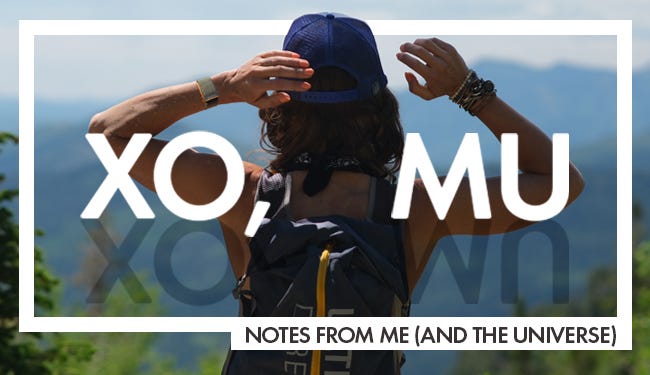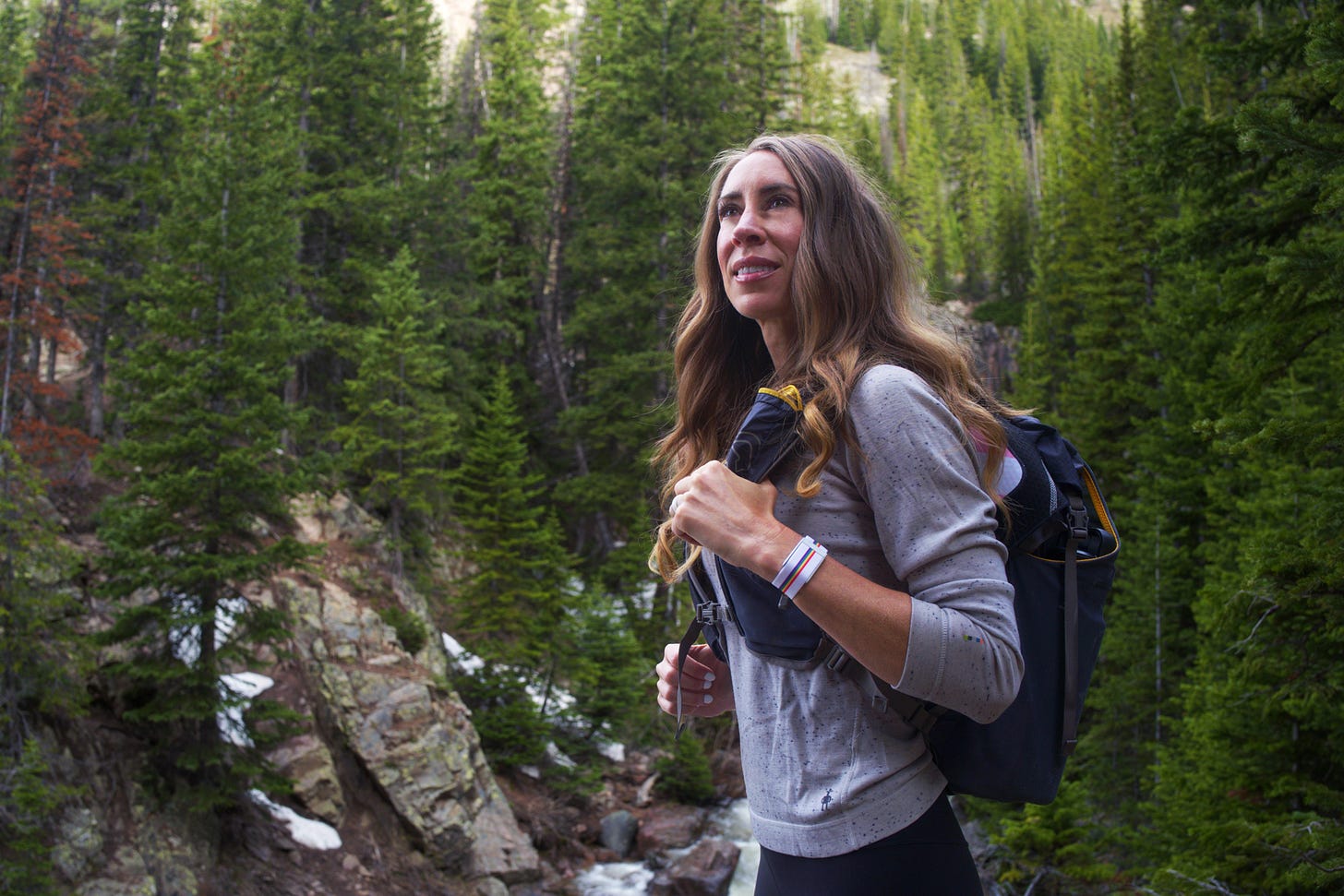XOMU: How to stay safe on a hike
Hiking alone can be restorative, joyful, and empowering. Here are some basic safety tips from someone who prefers to hit the trail solo.
This issue of XOMU is brought to you by WHOOP, my most-trusted tool for health and safety. Get a free month of WHOOP, plus a free WHOOP 4.0 and Black Onyx band
Remember the viral advice floating around a few years back that recommended changing your voicemail if you’re lost on a hike? The influencer said, “If you’re lost on a hike and your phone is about to die, change your voicemail message. Let people know where you are and what you’re doing (like waiting by the river) so if they try to call, they know how to find you even if your phone is dead.”
Upon first glance, this sounded like decent advice. Except, what if you don’t have cell phone service? You can’t update your voicemail greeting without it. And if you do have service and at least a little battery juice, shouldn’t you… call 911? Or search and rescue? Anyone with the resources to coordinate actual assistance?
I hike alone a lot—often 10-15 miles at a time in remote areas—and I take many steps to stay safe. Here’s how I prepare.
Share your plans
Well before you leave your house, download your trail using the AllTrails app (Pro account, see below), the National Park Service app if you’re in a park, or bring a paper map of the area with you. Yes, I said a paper map. There was zero cell service throughout Yosemite, and we ended up using paper maps to guide our road trips and hikes. If you’re using AllTrails, you can still navigate even without cell coverage, which helps you stay on the trail and go back the same way you came in.
I always text someone:
Where I’m going
The trail I’m going to do
What time I’m starting
How many miles I plan on doing
What time I should text them “I’m back safe,” including any breaks, photo opps, or swimming I may want to do along the way
What time they should call the authorities if I haven’t texted, giving myself a reasonable grace period
I make sure I text this info, because at 7 AM I don’t expect my husband to remember the specific name of the trail I’m on.
If I change locations on the fly due to trail closure or how busy it is, I will find cell service and text the change of plans before I go up. If I know I’m going to a canyon with zero service, I’ll plan in advance: “I’m planning on Big Water Trail to Dog Lake, but if parking is full I’ll head back down to Birch Hollow.” The point is, I make sure someone knows where I am ahead of time, even on my local trails.
If there’s a trailhead log-book, sign it neatly with the date and time. If there’s a ranger station, check in and share your plans. If you’re based at a hotel, tell the front desk person where you are headed and all of the above information. If you pass a gas station on your way to a remote trail, go buy something and talk to the clerk so they remember you. (I don’t listen to True Crime podcasts but it rubs off.) The point is, give yourself some accountability somewhere; ideally with multiple people.
Before the hike
I check two data points before I hit the trail: the weather, and my WHOOP Recovery score. Always check the weather before you leave, and check in the area you’ll be hiking, not the area of your home or hotel. (Temps between the mountains and the valley can differ by 20 degrees or more.) If you can’t check weather on the mountain, look at a map and search for the weather in the closest town. Be on the lookout for afternoon thundershowers, specifically, and designate a hard-and-fast turn-around time so you’re not caught on the mountain in lightning. (And if the weather looks grim all day, change plans.)
I also check my WHOOP Recovery score before I head out. Based on my score, I might adjust the length of my route or my pace. However, there are rare occasions where WHOOP keeps me safe before I’ve even left the house. While hiking in Moab this March, I woke up feeling okay, but noticed a Red recovery accompanied by a plunge in HRV and a sharp spike in both resting heart rate and respiratory rate. We called an audible and skipped the hike that day, deciding to drive home a day early. By the time we got home, I was floored by a high fever and nasty respiratory infection, my violent coughing punctuated by serious asthmatic episodes. Had I been miles out on a trail in that condition, things could have gone very wrong in a hurry.
During the hike
There are a few apps that can help you stay safe, but only if you have cell phone service. NEVER COUNT ON CELL PHONE SERVICE. If there’s one thing I want to impress upon you, it’s that.
Still, keep your phone handy and pay attention in case you randomly get a bar or two mid-hike. You can use those opportunities to text a check-in or update your emergency contacts with your location using an app. Once I lose service, I keep notifications and volume ON (I don’t put it in airplane mode or DND). If I pop into service at some point on the trail, my phone blows up with missed alerts, and I can stop to send a check-in text to my husband or sister. Also, be on the lookout for service specifically on peaks, as you can often pick up a few bars up high.
All Trails: With a Pro subscription ($30 a year), you can designate up to 5 contacts using their LifeLine feature, and share your planned start and finish time and date, your planned starting and ending location, and your real-time location on a map plotted against your planned route. If you experience data connectivity or GPS issues, however, your updates will be delayed until you’re back in service.
Strava: Their Beacon service is free if you’re using their mobile app (paid if you’re using a Garmin or Apple Watch). Share real-time location info with your contacts via text, updated every 15 seconds or so. Again, if you experience data connectivity or GPS issues, your updates will be delayed until you’re back in service.
What3Words: While most Search and Rescue teams don’t recommend using What3Words for emergency services (as your phone’s GPS can help them coordinate far better), this is a great one to use with friends and family if you need to give them directions to your trailhead or parking area. The key words make it easy to tell anyone exactly where you are anywhere in the world using three unique key words. (It’s way easier to say “classmate kennels benchmarks” than “like, part of the way up this lake trail?”) The app is free to download, but you have to have cell phone service to tell someone where you are using your keywords.
There are other apps (including Google Maps) that share location and status in real-time with selected contacts, but again, cell phone service is a requirement, and (is this horse dead yet?) you just can’t count on that.
Emergency comms
The ultimate emergency communication for camping, hiking, road trips, and any other situation in which you might not have cell coverage is a satellite communicator. These can be pricey, but if you travel alone often (or with your kids) it can be a literal life-saver.
Garmin InReach Mini: This is what I have. It’s about $400 with an inexpensive monthly subscription (starting around $12 a month). You can pre-program texts or emails to emergency contacts (“still on track” or “delayed by an hour but doing OK”), you can communicate two-way (so they can text you back), and if needed, you have a big SOS button that will send the helicopters and SAR team. Push only in cases of emergency because that sh*t is expensive, but if you need it, you’ve got it. (There are many options for satellite communicators, and cheaper one-way communicator options exist.)
(The InReach is handy in lots of situations, actually. If you’re on a road trip with long stretches without cell service, or camping, or doing big paddles, this thing can save your butt in case of a flat tire, getting lost, or a medical medical emergency.)
Personal Location Beacon: For folks who just want the SOS button. Most of these don’t require a subscription but are ONLY used in case of emergency, and have no two-way communication. (So you push it and pray.) But it should alert authorities to within 100 meters of your position, and some have a battery life of over 24 hours, so you may continually broadcast your location to rescuers if you’re moving. Probably a bit too intense for your average day-hiker, but if you fly a glider or mountaineer, this might be fitting.
Practical advice
Aside from the technical gear and the preparation you do before you hit the trail, there are some basic safety actions I keep in mind as I hike, to protect me from predators. (Men. Not bears. I’m talking about men.)
No headphones. I know it’s tempting to listen to music or a podcast during a long hike, but stay aware of your surroundings. (This will also help you avoid snakes, moose, and mountain bikers on the trail.)
Say hello to everyone. I’m notorious for greeting everyone on the trail. Yes, I’m friendly and happy, but I also want to be memorable. I make eye contact, say hello, and offer an, “I’m doing great, how’s your hike?” in response so people know I’m alert, energetic, and present.
Carry pepper spray. If I don’t need bear spray, I keep a canister of pepper spray in an easily accessible front pocket, ready to go. (You could even carry it—just make sure you’re comfortable using it.) One of those loud personal alarms would work too, if you’re uneasy using pepper spray. Or poles, even! Anything that could scare someone away if needed.
Trust your gut. I would rather the man hiking behind me think I’m an a**hole than get murdered. If I’m at all uncomfortable, I’ll very directly say, “I’m going to stop here for a while—please keep going.” Or I’ll wait until a group comes by to continue, or even start back down the trail real fast. I’ve even said to two older men on the trail, “I’m not going to be weird about it, but I’d like to keep you in sight as we hike up, because I’m alone. Is that cool?” (They were super friendly.)
I pray none of you (or me) ever needs these kinds of emergency services, but it’s better to be prepared, as even experienced hikers can find themselves lost, in a jam, or injured. Do you have tips, apps, or other resources you’d like to share for solo hikers? Email me your responses.
XO MU
P.S. Join WHOOP now and watch your September Whole30 non-scale victories accumulate in real time! Your first month is free, and we’ll have a good group chat going via the app in the WHOOP Whole30 Team.






This is very helpful. Thank you. I hike by myself all the time. I definitely need to level up.
Thank you so much for these tips. I just did my first solo hike and loved it but didn’t think about any of these things. 😬